ECU VOLKSWAGEN GOLF 2005 User Guide
[x] Cancel search | Manufacturer: VOLKSWAGEN, Model Year: 2005, Model line: GOLF, Model: VOLKSWAGEN GOLF 2005Pages: 444, PDF Size: 92.7 MB
Page 156 of 444
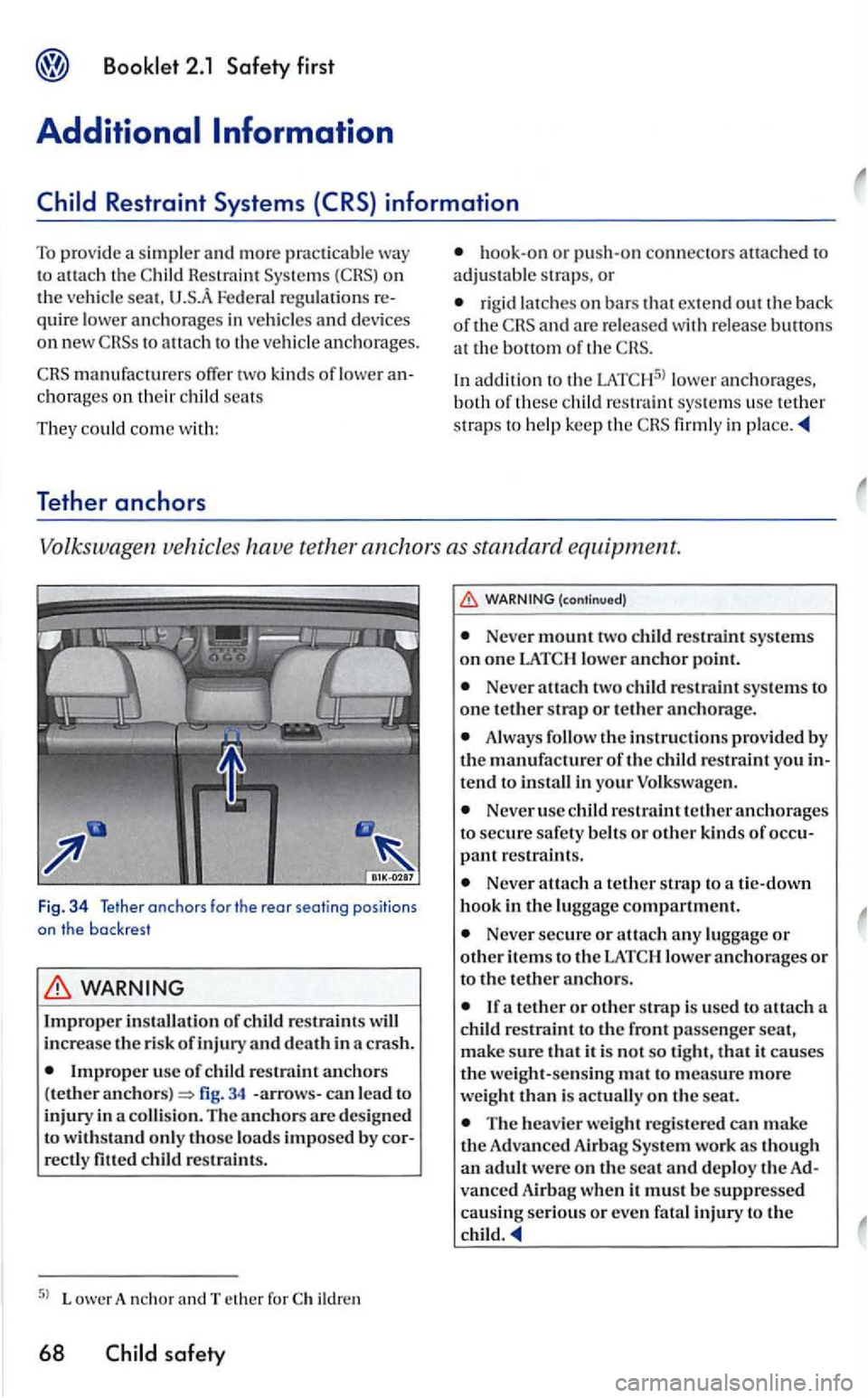
to attach the Res tra int on th e veh icle seat. Fe deral regularions quire lower anchorage s in vehicle s and devices to attac h to th e ve hicle anc horages.
ch o rage s on their chi ld sea ts
They could come w ith :
Tether anchors
hook-on or pu sh- on con nec tors att ached to
adjustable straps, or
rigid latc hes on bars that exte nd out the back of the e ns and are re lease d with release butto ns at th e bo tto m of th e ens.
I n add
ition to the l ower anchorages,
bo th o f thes e child res traint use te th er
stra p s to help keep the e ns firml y in place
Volkswagen vehicles have tether anchors as standa rd equipment.
Fig. 34 Tether anchors for the rear seating positions on the backres t
Improper use of child restraint anchors
( tether fig . 34 -arrows -can lead to
injury in a collision. The an ch ors are de signed
to with stand only those loads impos ed by rectly fitted child restra int s.
Lower A nch o r and Teth er for ildr en
68 safety
(co ntinu ed)
Never mount tw o child re strain t systems on one
Never att ach two child re stra int sys tems to one tether strap or tether anchorage.
Always follow the instructions pro vided by tl1e manufacturer of the c hild restrain t yo u tend to install in your Volkswag en.
Neve r use child restra int tether anch o rages
to secure safety belt s or other kind s of
Never attach a te ther to a tie-d ow n
hook in th e lugga ge compartment .
Neve r secure or attach any lug gage or oth er it ems to th e lower anchorages or
to the tether anchor s.
If a te ther or other strap is used to attach a
c hild res traint to the front passeng er seat,
m ake s ure that it is not so tig ht, th at i t ca uses the weight- sensing mat to measure more
we ight than is actuall y on the seat.
Th e heav ie r weight registe red can make Advanced A irba g work as th ough an adult were on the sea t and deploy the vanced Airbag when it must be suppresse d
causing serious or even fatal injury to th e
c hild
Page 157 of 444
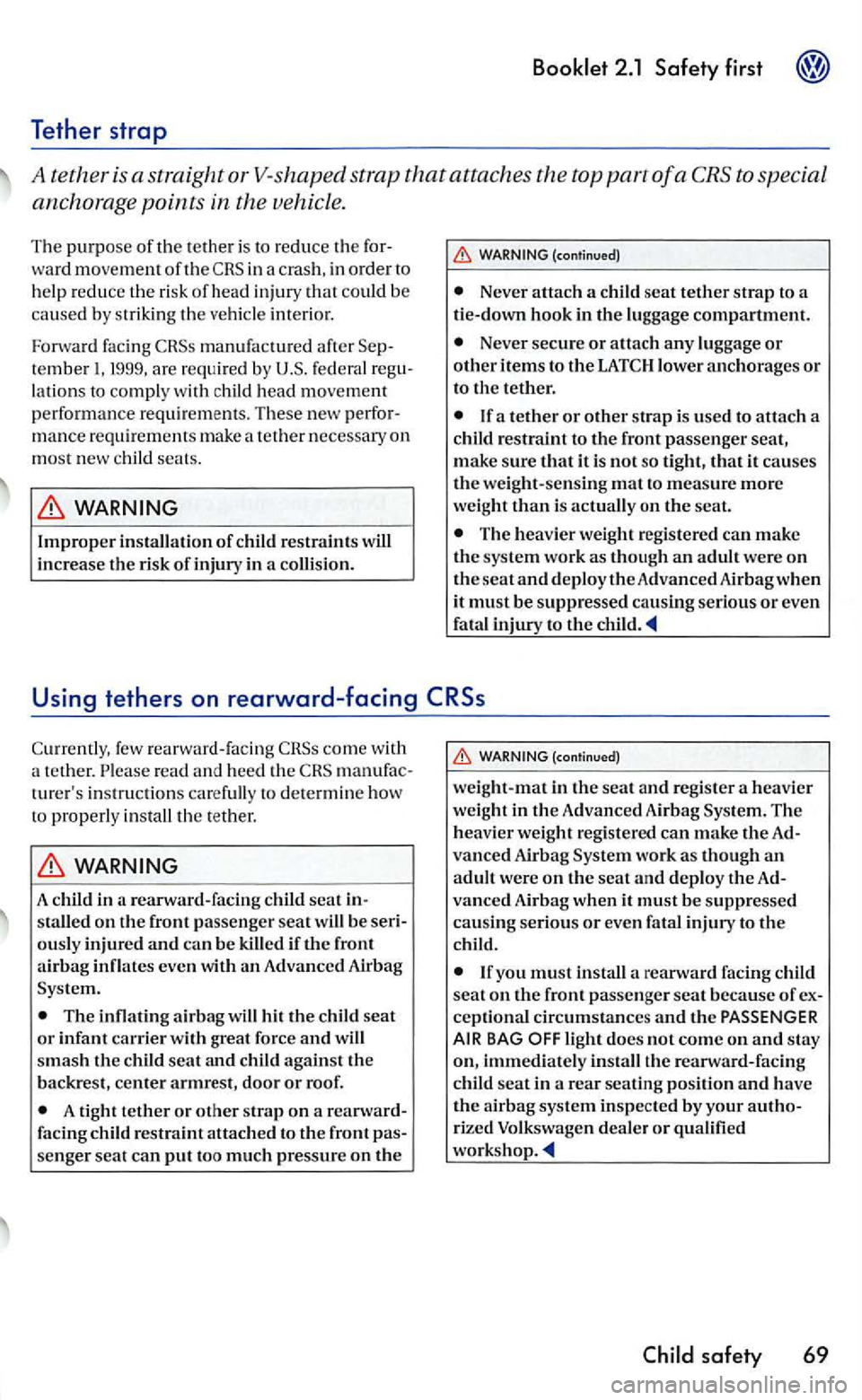
ward movem ent of the in a cras h, in order to h elp reduce the risk of head injury that could be caused by s triking the vehicl e interior.
Forward facing
manufactured after tember
Never attach a child seat tether strap to a
tie-down hook in the luggage compartment.
Never secure or attach any luggage or other items to the
tether or other strap is used to attach a
child restraint to the front passenger seat, make sure that it is not so tight, that it causes the weight-s ensing mat to measure more weight than is actually on the seat.
The heavier weight registered can make the system work as though an adult were on the seat and d eploy the Advanced Airbagwhen
it must be suppressed causing serious or even
fatal injury to the
f e w rearward- facing
turer's in struc tion s carefull y to determin e how
t o properly install the tether.
A child in stalled on the front passenger seat will be
The inflating airbag will hit the child seat or infant carrier with great force and will smash the child seat and child against the
backrest , center armrest, door or roof.
A tight tether or other strap on a facing child restraint attached to the front senger seat can put to o much pressure on the
Page 159 of 444
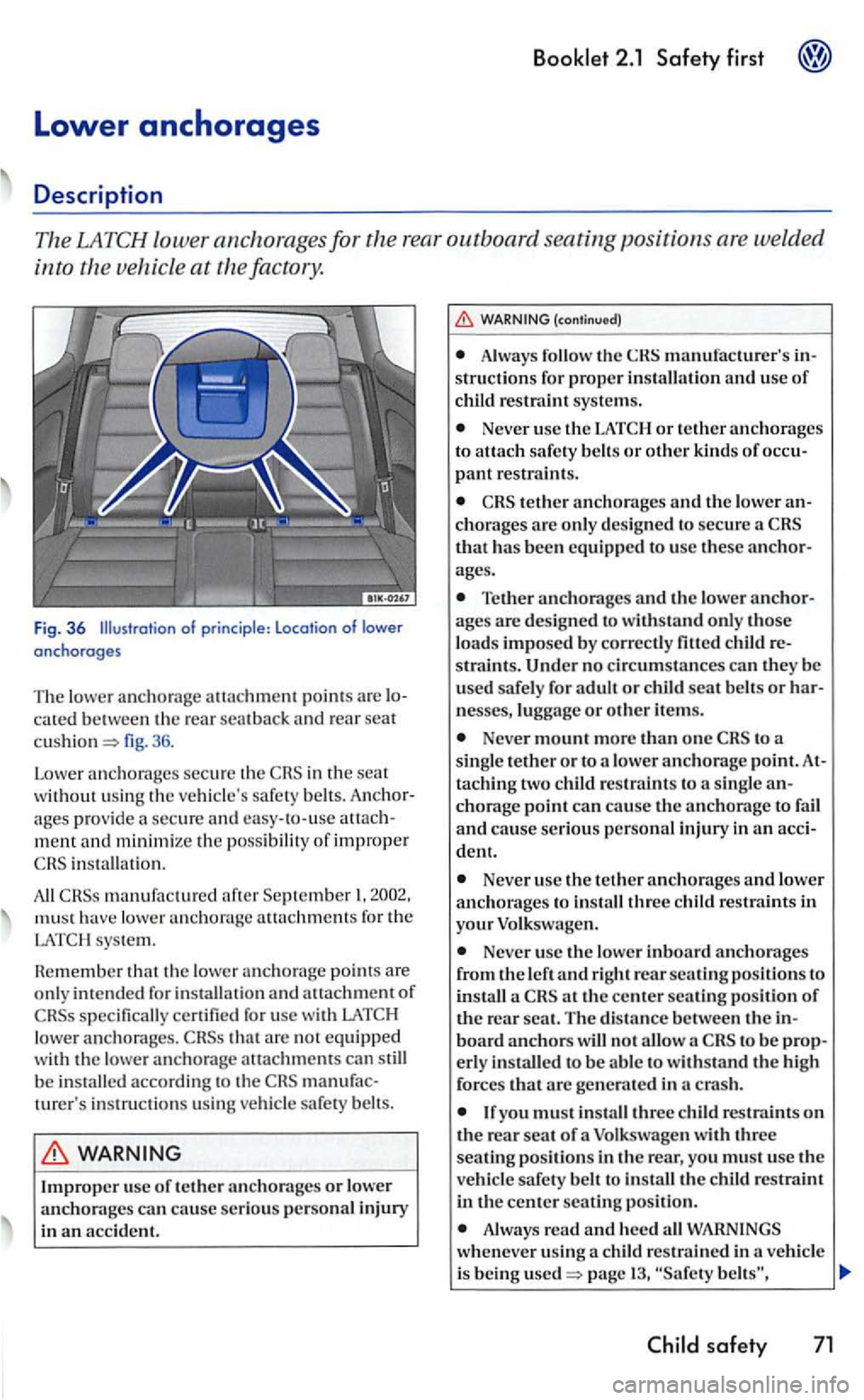
Booklet 2.1 Safety first
T he lower an chorage au ac hme nt poi nts are lo
ca ted between the rea r sea t ba ck and rear seat
cushion fig . 36 .
Lower anchor ages sec
ure the in the seat without using th e ve hicle's safety belts. Anc hor
ages provide a secure and easy- to-use attach
m ent and minimi ze the poss ibilit y of improper
manufa ctured after Sep te mber mu st lower allachment s fo r th e sys te m.
Hem ember th at th e lower anchorage points are
only intended for installation and all achment of
lowe r a nchorages. that are not equipped
w ith the lowe r a nchorage auachrnents can still be installed accord ing to the m anufac
turer' s inst ruc tion s using vehicle safe ty belts.
(continued)
Always foll ow the C HS m anufacturer's in
s tru ction s for prop er in sta llation and use of child restraint syste ms.
Never usc the or te ther an chorage s
to attac h safe ty belt s or other kinds of occupant restraint s.
tethe r anch ora ges and the lowe r anchorag es arc only des ig ned to sec ure has be en equipp ed to usc these anchor
a ges.
Tether anchorages and the lowe r an ch orage s are designed to withstand only those loads imposed by correc tly filled child re
straints.
Neve r mount more than one to a
single te ther or t o a lowe r a n chora ge point. Attaching two child restraint s to a sin gle an chorage point ca n cause the anchorage to fail and cause serious person al injury in an accident.
N eve r u sc the tether anch ora ges and lower anch orages to install three child restra ints in
you r Volkswag en.
Never use the low er inboard anchorages
from the left and right rear se ating position s to
in sta ll a at th e ce nter sea ting position of rear sea t. T he di stance between th e in board anchors w ill no t allow a to be prop
e rl y i nstall ed to be abl e to with stand the hi gh
f orces that are generated in a cras h.
you must in stall three child restra ints on the rea r seat o f a Volk swagen with three
seating positions in the rear, you must u se the vehicle safety belt to install th e c hild restraint in the center seating position.
Always read and heed all WAR NINGS
wh enever u sin g a c hild res train ed in a vehicl e
i s being used page
safety 71
Page 161 of 444
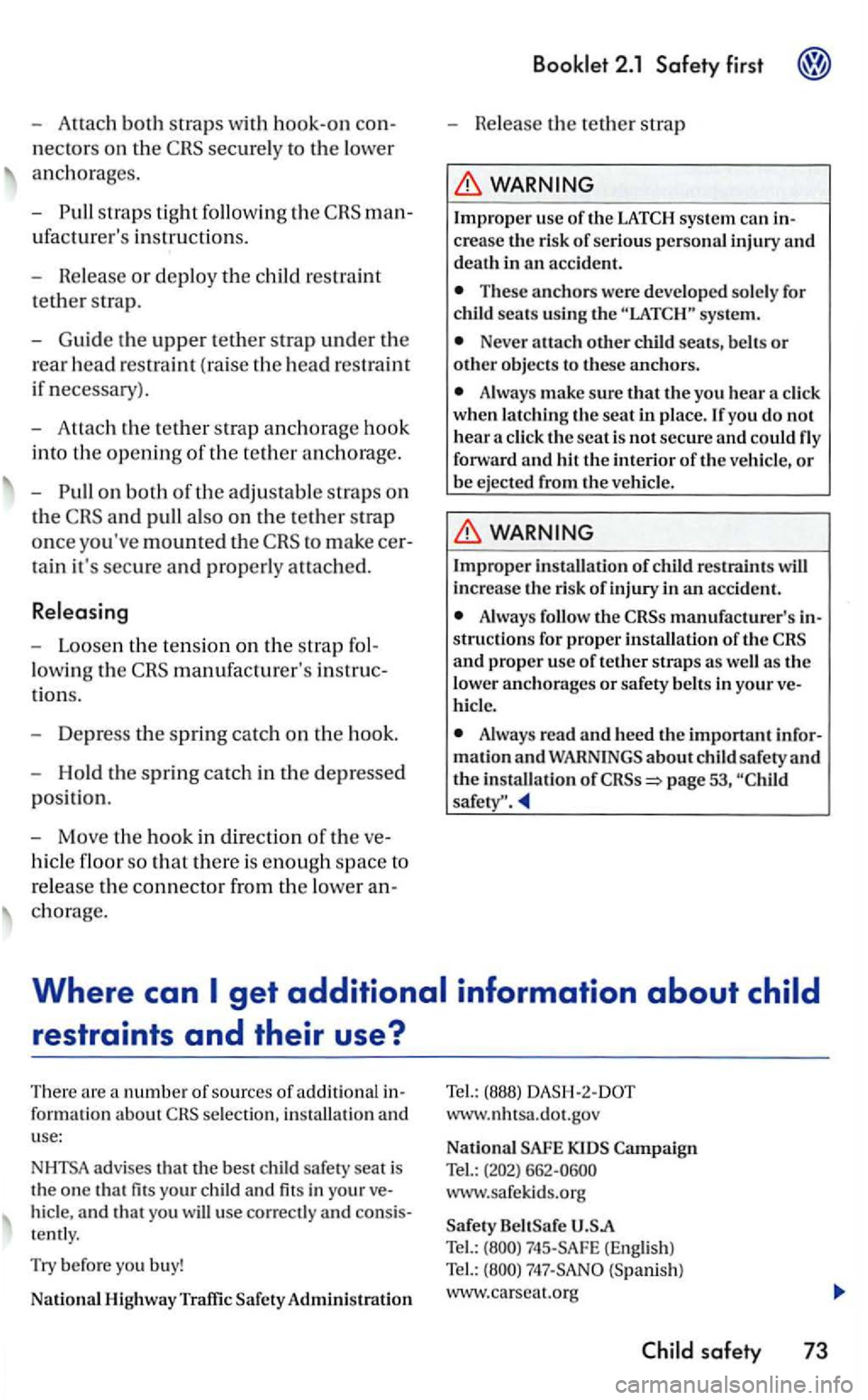
-both straps wit h hook-on con
n
ect ors on the secu re ly to the lower
a n ch orages.
- P ull str ap s tig
ht foll ow ing th e man
ufacturer's instr uctio ns.
-Release or deploy th e ch ild rest ra in t
tether strap.
- Guide th e
upper tether strap under th e
rea r
head restraint (ra ise the head restra int
if n ecessary).
- Att
ach th e te ther s trap anch orage hook
int o th e o pe
ning of th e te ther a n ch o rage.
- Pull on
both of the adjustable straps on
th e
to make cer
t ain it's secure a
nd properl y attached .
Relea sing
- Loose n th e te nsio n on the stra p f ol
l
owing t h e manufacturer's in stru c
t i
ons.
- Dep ress the sprin g catch on th e hoo k.
- Hold th e s prin g
catch in th e dep ressed
p os ition .
- Move th e h
ook in direct ion of th e ve
hicle floo r so that the re is en o ug h space to
r e lease th e co
nnecto r f ro m th e lowe r an
c h o rage.
Booklet 2.1 Safety first
-Release the te th er str ap
WARNING
Impro pe r u sc of th e sys te m can in
c re a se the risk of serio us personal inju ry and death in an accid ent.
Th ese anchors were developed sole ly fo r seats usin g the sys te m .
Neve r attac h oth er child seats,
A lways make sure th a t the yo u hear whe n l atc hin g th e seat in place.lfyou d o not
hear f orward and hit th e int erior of the ve hicle, or
b e e jecte d from the ve hicl e.
WARN ING
Im proper in sta ll ati on of restra in ts
A lways manufacturer's
as the
l o w er anch orages or safety belt s in your ve
Always read and heed th e i mportant infor
m ati on an d about safety and the in sta ll ati o n of
se lectio n, in stalla tion and
use:
N
HTSA advises that the best child safety seat is
t h e o ne that fits your c hil d and fits in your veand that you will use correct ly and consis
tent ly.
Try befo re you b uy!
Nat ional High way Traffi c Admini stration
Tel.: (888) www.nhtsa.do t.gov
Nati onal Tel.: (202) 662-0600
www.safekids.o rg
www.ca rseat.o rg
safety 73
Page 225 of 444
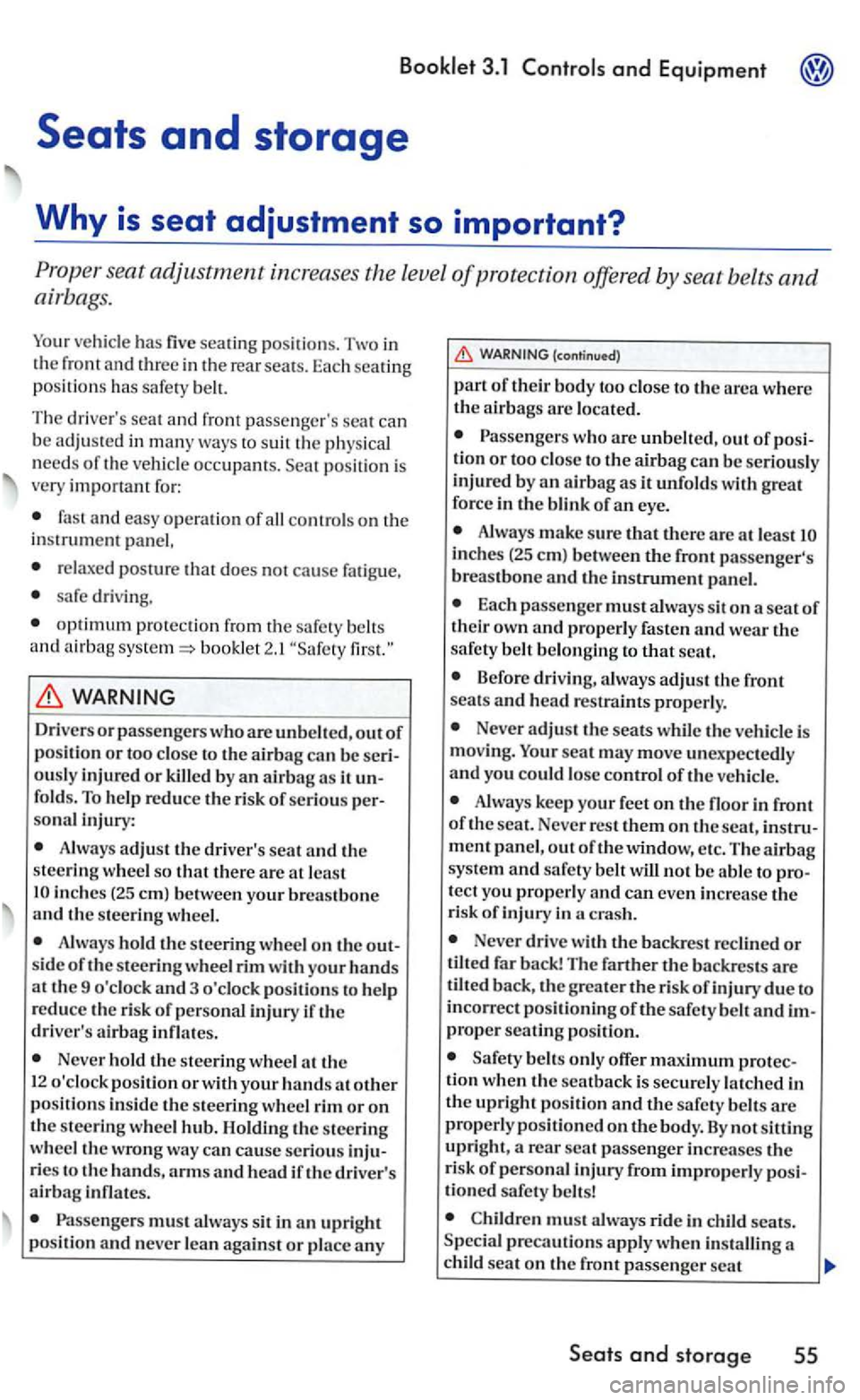
Booklet 3.1
passe nger's seat can
b e adju ste d in many ways to suit the physical
need s of the vehicl e occ upants. position is
very important for:
fast and easy operat ion of all control s on the instrument panel,
safe driving ,
optimum prote ction from the s afet y belts
and airb ag booklet 2.1
Driv ers or passengers who are unbelted, out of position or too close to the airb ag can be seri
ously injured or killed by an airbag as it unfolds. To help reduce the risk of serious personal injury:
Always adjust th e driver's seat and the steeri ng whe el so that there are a t lea st in ches (25 em) betwe en you r brea stbone and the ste erin g w heel.
Always hold the steering wheel on the out
s ide of th e s teering wheel rim with your hands at the 9 o'clock and 3 o'clock position s to he lp
reduce the risk of personal inju ry if the driver 's airbag inflates.
Never hold the steering wheel
Passengers must always sit in an upright position and never lean agains t or pl ace an y
(co ntinued)
part of their body too close to the area where the airbags are loca ted.
Alway s make sure there are at least inch es (25 em) between instrument panel.
Eac h passenger must always sit on a sea t of their own and prope rly fasten and wear the safety belt belon ging to that scat.
Before driving, always adjust the front
seats and head r estraints properly.
Never adju st th e sea ts while the vehicle is
moving. sea t may move unexpec tedly and yo u could lose control of the vehicle.
Always keep your feet on the floor in front of the sc at. Never rest on tl1e in strument panel, out of the window, etc. The airbag
s ystem and safety belt will not be able to pro
te ct you properly and can even increase the
ri sk of injury in
Never drive with backres t reclined or tilted far backJ The the backres ts are t ilted back, greater risk of injury due to
incorrect positioning ofthe safety belt and im
proper seating position.
b elts only offer maximu m prot ec
tion when the se atback is securely lat ch ed in
Children must alway s ride in child seats.
Seats and storage 55
Page 227 of 444
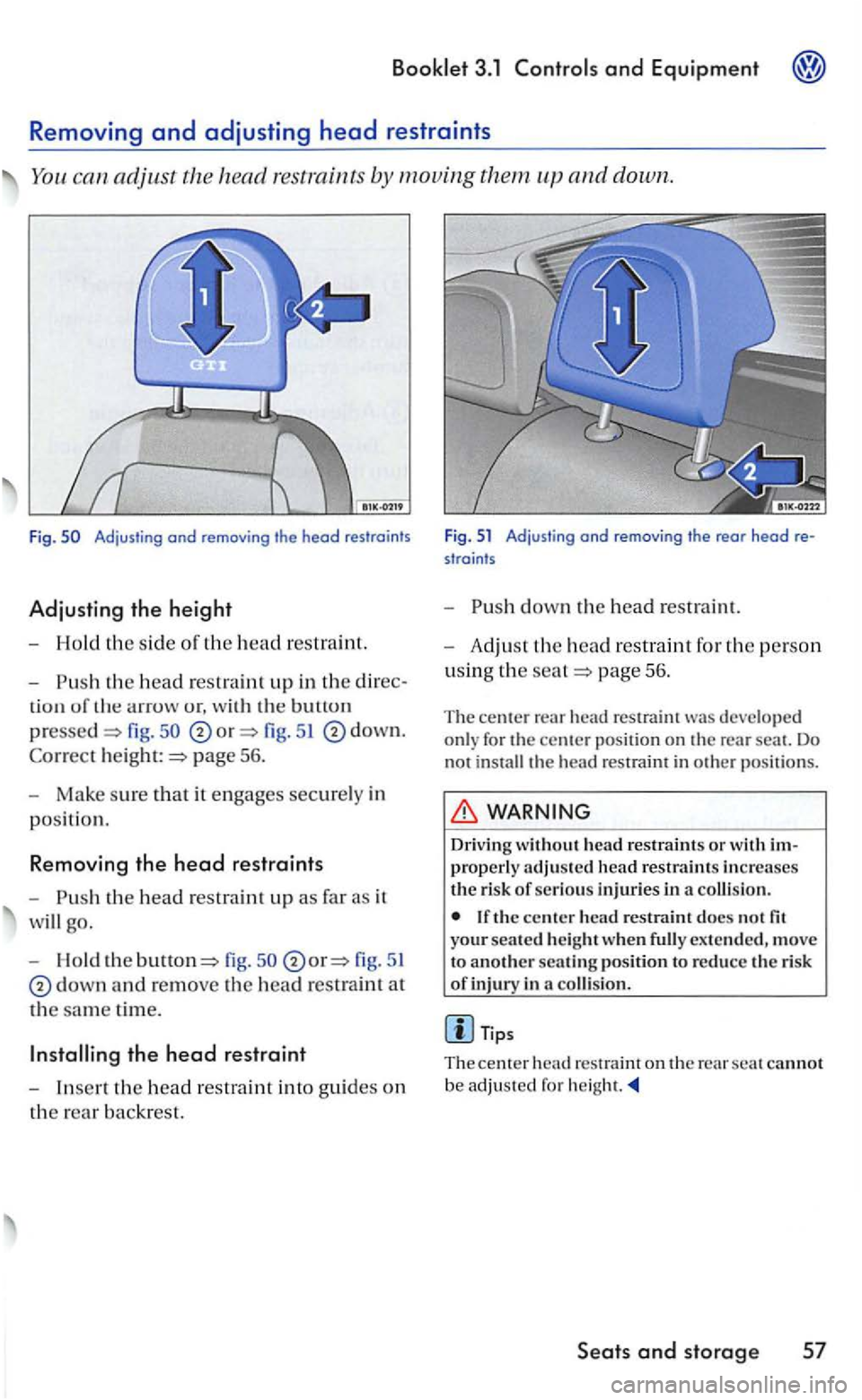
and Equipment
adjust the head by moving them
u r, w ith bullun
pressed fig. 51 down.
page 56.
- M ake sure tha t it engages securely in
position.
Removing the head restraint s
-
th e fig . fig. 51
down and remove th e head restraint at
the sam e time.
th e head restraint in to guides on
the rear backrest .
F ig. 51 Adjusting and removing the rear head re
straints
-
page 56.
T he ce nter r
ear h ead res train t deve lo p ed
o nly for the center p osition on th e rear seat. Do
not install the head restraint in oth er p ositio ns.
Driving without h ead restrain ts or
th e ce nter head restra int do cs not fit your seated h eig h t w he n full y exte nded, move
t o another s ea tin g posi tion to reduce the risk of inj ury in a collis ion.
Tips
The ce n te r h ead
res traint on the rear scat ca nn ot
b e a dju ste d fo r height.
Seats and storage 57
Page 232 of 444
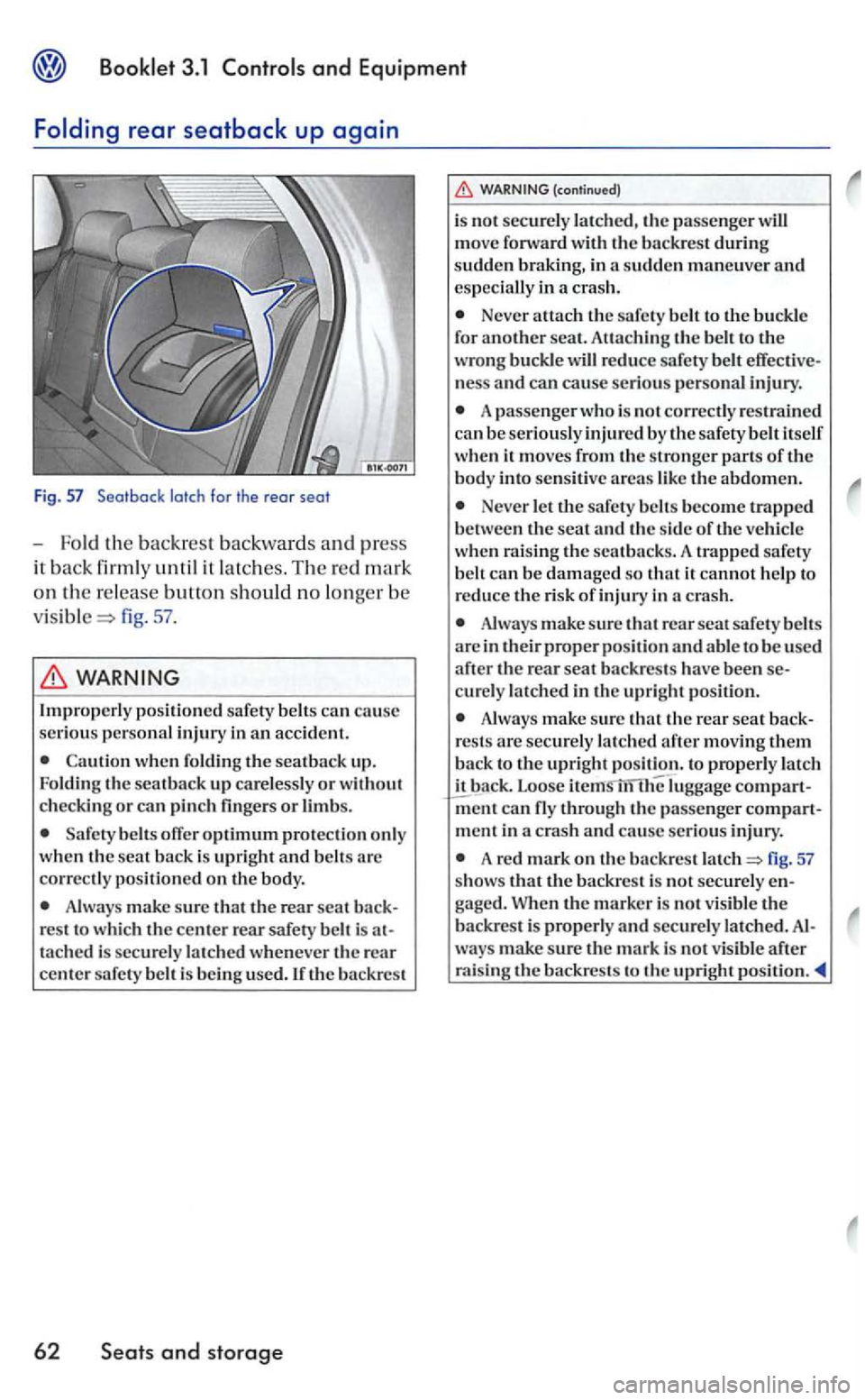
and Equipment
the backrest backwards and press
it back firmly until it latches. The re d mark
o n rhe release button should no lo nge r be
fig. 57 .
when foldin g the seat back up.
Folding the seat back up care lessly or without
c h ecki ng or ca n pin ch fin gers or limbs.
belts offer optimum protection only
w hen the sea t back is upri ght and belts arc
correc tly po sitioned on th e body.
Always make sure that the rear seat res t to whic h th e cente r rear safety belt is t ached is securely la tched whenever the rear center sa fety be lt is use d. If the backrest
62 Seats and storage
(con tinued)
is not secu re ly latched, the passenger move forward with the backrest during
sudde n braking , in a sudden maneuve r and espec ially in a c rash.
Never attach th e safe ty belt to the buckle
for another seat. Attaching the belt to the wro ng buckle ness and can cause serious pe rso nal injury.
A passenger who is not correctly restrain ed
ca n b e se riousl y injured by th e sa fety belt itself
when it move s the strong er parts of the body into sensitiv e areas like the abdomen.
Never le t th e safety belts beco me trapped
between the seat and the side of th e veh icle
when rai s in g the sea t ba cks. A trapped safety
b elt can be damaged so that it cannot help to
r e du ce the risk of injury in a crash.
Always make sure th at rear seat safety belts are in their proper position and able to be used
after the rear seat b ackres ts have been
Always make sure that the rear seat rests are sec urely latched after moving th em
b ack to the upright position. to properly latc h
it bac k. Loose
m ent in a crash and cause se rious injury .
A re d mark on the ba ckrest fig. 57 show s that the ba ckres t is not securely gaged. When the m arker is not visible the backrest is properly and sec urely latch ed. ways m ake sure the mark is not visibl e after raising the backre sts to the upright
Page 233 of 444
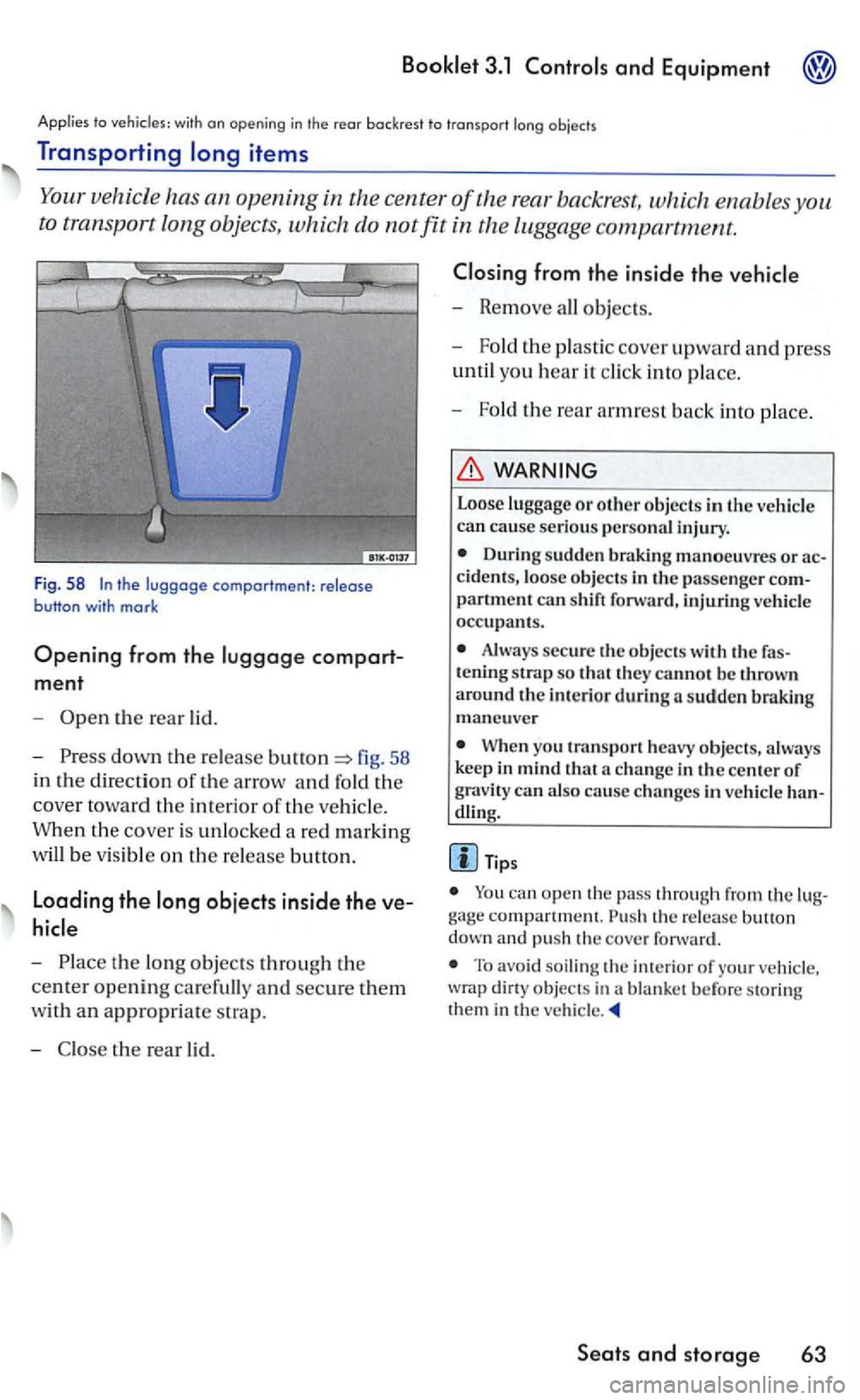
vehicle has an the center of the rear backrest, which en ables
to transport long objects, which do not fit the luggage compartment.
F ig. 58
compart
ment
-the rear lid.
-
down the r e lease fig. 58
in the
direction of the arrow and fold the
cover toward the interio r of the ve hicl e.
When the cove r is
unlocked a red marking
wi
ll be v is ible on the re lease button.
Loading the
-
- Remove all objects.
- Fold
the plastic cover upward and p ress
until you hear it click into p lace.
-
Fol d th e rear armrest back into place.
WARNING
Loose luggage or other objec ts in the ve hicle can cause serious personal injury.
D uring sudden braking manoeuvres or
partment can shift forward, injtuing vehicl e occupants.
Always secure the objects the tening strap so they cannot be thrown around th e in te ri or during sudden maneu ve r
Whe n yo u transpo rt heavy objects, always
keep in mind that
dl ing.
Tip s
can open the pass through from the compartment. release down and pu sh the cove r forward.
To avoid soiling the of your vehicle , dirty objec ts in a blanket before storing them in the vehicle
Seats and storage 63
Page 236 of 444
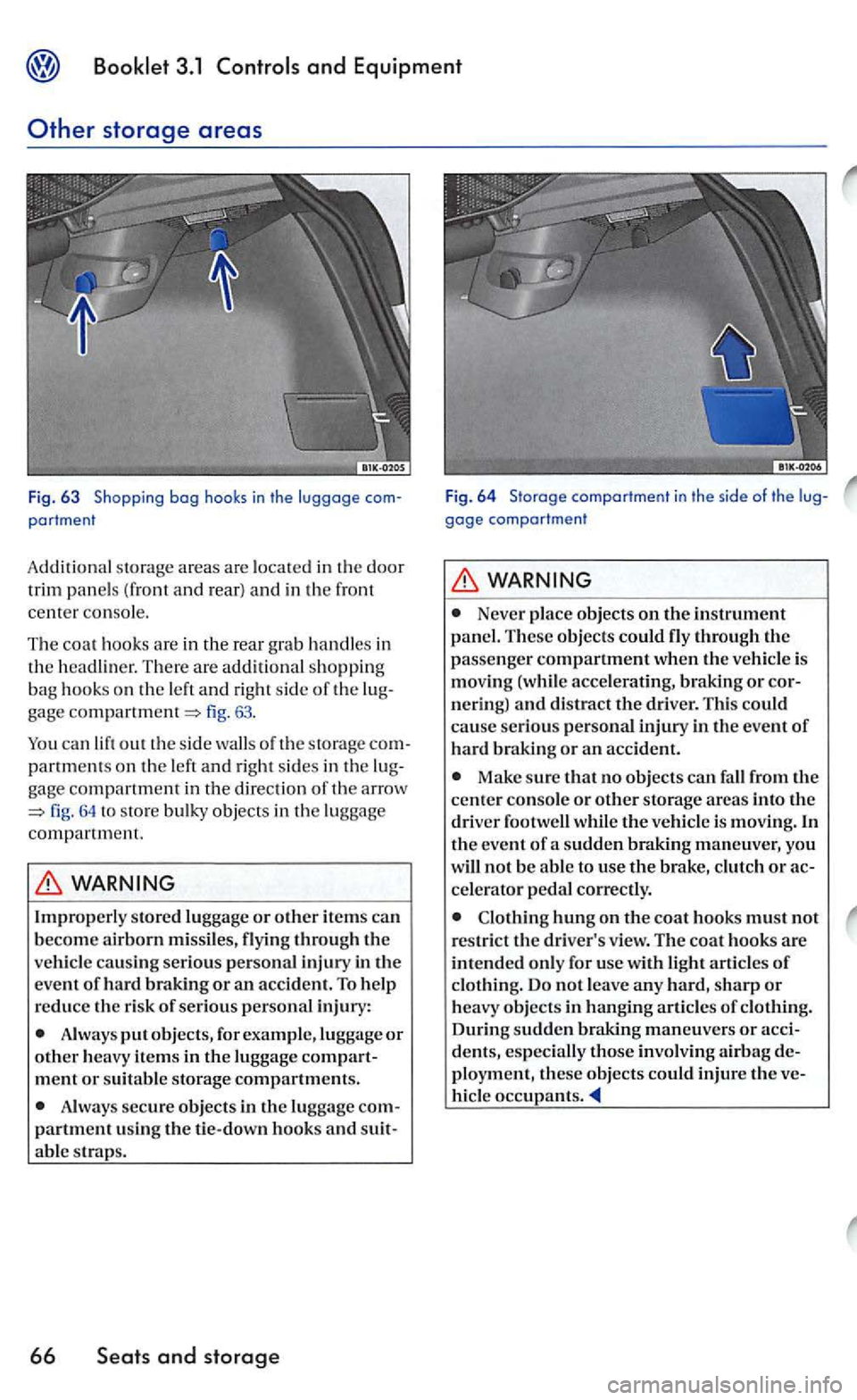
and Equipment
Other storage areas
Fig. 63 Shopping bog hooks in the luggage portment
Additiona l s torage areas are located in the door
trim panel s (f ront and rear ) and in the front
center console.
The coat hooks are
in the rear grab hand le s in th e There are add itional shopping
bag hook s on the and right side of the fig. 63.
out the s ide of the storage partm ent s on the and right sides in the
fig. 64 store bulky objects in the luggage
com partm ent.
Always put objects, for example, lug gage or other heavy items in the luggag e compartment or suitabl e storage compartments.
Always secure objects in the lu ggage partment using the tie-down hooks and able straps.
66
gage comportment
Never place objects on the instrument
panel. These objects could fly through the
passeng er compartm ent when th e is mov ing (w hile acce lerating, braking or n ering) and
Make sure that no objects fall from the cente r console o r other sto rage areas into the
dri ver footwell while the is m ov ing. In the event of a sudden brakin g maneuver, you
w ill not be able to usc tl1e brake,
hung on tl1e coat hooks must not rest rict the dri ver's view . The coat hooks arc intended only for usc with light of
of During sudden braking maneuvers or acci-
d e nts, especially those inv olv in g airbag de
ployment , these objects could inj ure the ve-occupants.
Page 239 of 444
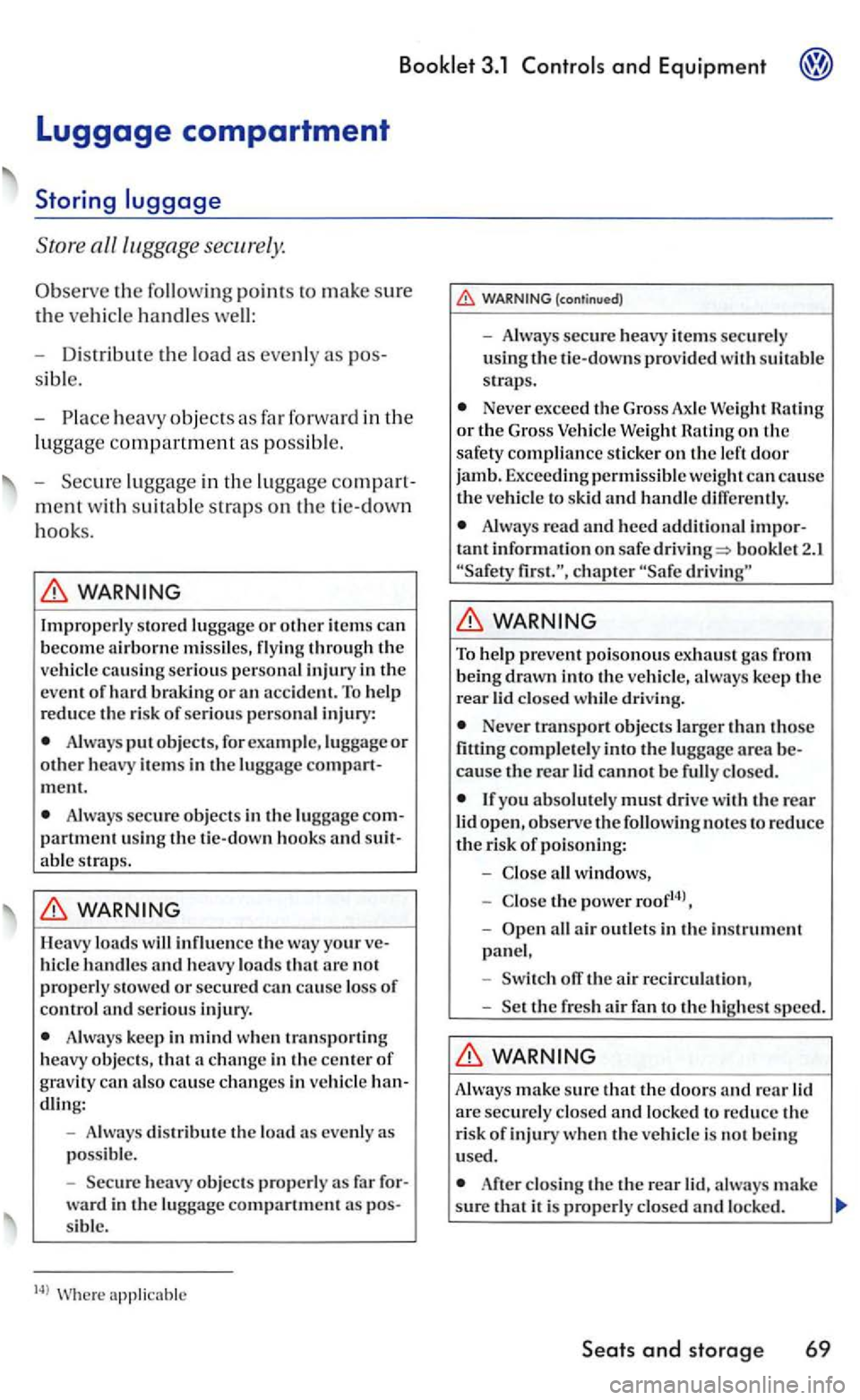
and Equipment
the following points to make sure
the ve hicl e handles well:
- D is tribute
the load as even ly as
heavy objects as far forward in the
lu ggage compartment as possibl e.
-
luggage in the lug gage compart
men t w ith suitable s traps o n the tie-down
hooks.
WARNING
Improperly stored luggage or other item s can become airborne mi ssi les, fly ing through the
ve hicl e ca using seriou s personal inju ry in the even t of hard braking or an acc ident. To help
reduce th e risk of serio us personal injury:
Always put objec ts , for example, lu ggage or other heavy item s in the lugg age compartment.
Always secure objec ts in the luggag e partment usi ng the ti e-down hook s and suit able straps.
WARN ING
Heavy loads will influ ence the way your hicl e handles and heavy loads that arc no t properly s towed or secured serious i njury.
Always keep in mind when transp o rtin g
heav y objec ts, that change in the center of g ravity can also cause ch anges in vehicle
eve nly as possible.
- Sec
ure heavy objects prop erl y ward in the compartment sibl e.
Where applicahlc
(con tinued)
- Alwa ys secure heavy item s securely
u sing the ti e-downs provided w ith suitable
straps.
Neve r exceed the Gro ss Axle Weight Rating or th e G ross Vehi cle Weig ht Rating on the safety compliance sticker on th e
Always read and heed add itional tant information on safe booklet 2.1 chapter driving"
WARNING
To help prevent po isonous exhaus t gas from being drawn into the veh icle, always keep th e rear lid
Never transport objec ts larger than tho se
fittin g co mpletel y into th e luggag e area cause the rear lid cannot be fully closed.
Lfyo u absolu te ly must drive wi th the rear lid open, observe the following notes to reduce the risk or poi soning:
-
the pow er roof14l,
-all a ir o utle ts in th e in strument pane l,
- Switch
the air recirculation ,
-
Set the fr es h air fan to the highe st sp eed.
WARNING
A lwa ys make sure that the doors and rear lid are securel y clo sed and locke d to red uce the
risk of in jury when the vehicl e is not bein g
u sed.
locke d.
Seats and storage 69